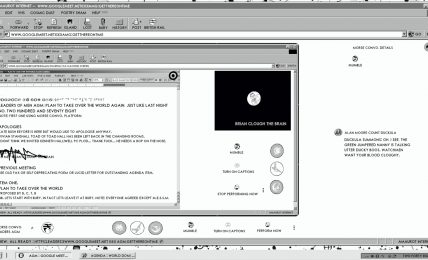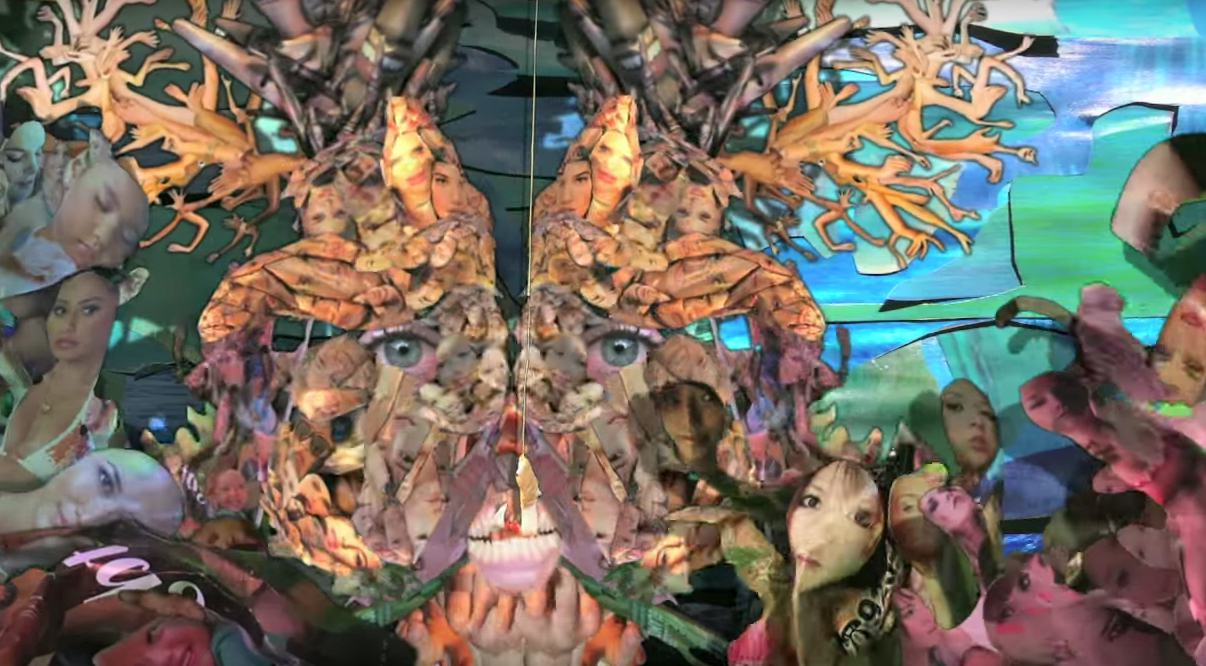I stepped into a frame in which artist Karissa Hahn allows for no escape. Just as how Nam June Paik employed a conceptual use of video in Buddha Watching TV, in which a camera and a monitor loop in real time, Karissa Hahn destructs parallels of frames so that she could arrive at the essence of manufactured images. But her infinite loop blurs the object–subject distinction and primary layer of image loses its existence in this karma.
Hahn’s Please step out of the frame (2018) uses Super 8, a desk, and a laptop to create a playful visual study of “frame-within-frame” concept and the choreography of body and screen. The piece is intellectually challenging to appreciate because of its incorporation of video feedback in a way to create layers of reality. By digitizing herself into a video, Hahn switches between subject and object and informs a loss of reality and dehumanization in interrupted frames.
Hahn also plays with zooms of the camera to imitate the process of stepping in and stepping out of the frame. At some frames, she is editing the videos, at others, she merges with the video itself or she tries to emulate what’s happening in the video. The video thus explores three layers of frames: the first layer of the viewers, the second layer of Hahn who is editing the video, and the last layer of the video in the laptop which incorporates more frames inside. This frame-within-frame concept arises intriguing questions: which layer is the reality? Which reality and which video work does Hahn wants to present to us? How do parallel of layers affects the presentation of works? If we consider audiences’ reality as the standard, Please step out of the frame is the work she wants to display. Hahn in the second layer and her frames helps us to arrive at the final project. At this level we are inspected by the artist since she controls what we can see in the project. However, if we consider the second layer as the “reality”, Hahn is not a character anymore–she owns self-awareness. At this reality, the artist put us in a higher level of person so that we become cameras or inspectors whom are examining the characters inside the frame (as how we control a character in a video game). For the last layer which are the frames within the laptop, they dissipate through the loops of frames as the vertical depth of the layer increases; then the loops and layers can continue. The notion of loop shares similarity with TV Buddha but Hahn extends it at the same time.
The most primary image or video equals to the Buddha who is captured and displayed on a screen – a close loop of feedback. However, Hahn continues to add another recording devices and screens on top of it and thus creates a second layer of the reality. Imaging if we add another Buddha watching the first installation and record and display the second one on the screen. Although each video is a close loop, Hahn could add a new layer on top of the old one indefinitely. Therefore, as the project goes unlimited, it is impossible to trace back to or even look at the primary image, in which the project is established. Therefore, as the layers duplicate, the first layer finally loses its existence in the reproduction and extension of itself.
Now which is reality of frame?
The reality loses its origin in karma.
As the video continues, Hahn asks how the body of the performer occupies the interface between these two distinct media. She challenges us to reinvestigate the human-media interaction that how do we humanize the technology and the electronic medium. The computer program scans Hahn and imports part of her into frames of world, and thus represents the interface between human and video. A moving roller coaster, a personal photo series, mirror of the camera. We are provided not only the hint for layers of the frames, but also the awareness of digitizing oneself and the fragmentation of digitized reality. Here exists an interesting subject-object relationship in digitizing oneself. When we upload any photos, videos or digital works about ourselves, we changed ourselves from subject to object, and the new subjects will be someone who clicks on those links; the actions continue, and we never end switching between subjects and objects. But the problem is that information is broken apart or even distorted. Just as how we merely capture the images of Hahn in the video, either though digitized avatar or photos, others also capture us through fragments of information. We own our awareness as human, but we are at the same time dehumanized as interrupted frames through internet and through thousands of transmissions of information online. True individual entities are similar to the primary piece of video or the primary layer of reality, but as the artists (ourselves) increase the records and displays through digital media, our entities dissipates as the fragments in the loop.
Ironically, the way to solve the problem is to continue this loop. Nam June Paik once stated in Cybernated Art that “we can resist poison only through certain built-in poison, then some specific frustrations, caused by cybernated life, require accordingly cybernated shock and catharsis”. By explicitly digitizing herself in a video, Hahn pointed out this dilemma that since we can never escape from the loop, the only way to exists in the loop, or to be aware in the loop (to resist poison) is to keep digitizing ourselves and exist in a higher layer of reality (a built-in poison).
As Hahn intentionally manipulates the priority of difference layers of frames, she discredits the aggregate narration within them and pointed out the dilemma of digitized reality. Viewers who dive into the narrative bring their own interpretations to the piece, to decide which reality to believe, to decide whether to escape the digitized loop, and to decide how to retain true entities within infinite frames.
We are presented the logic artifice, and in this empire of computer and us, we can never step out of the frame.
You can view Hahn’s piece here.
:::

Yuwei Lin studies Studio Art and Business at the University of Richmond. She is a printmaker and multi-media artist. Her works are often inspired by philosophical dilemmas, animations and human-tech interaction in video games. Plus, she insists video games are the ninth category of art and believes that it has the potential to achieve artistic expression that is unique to games.



